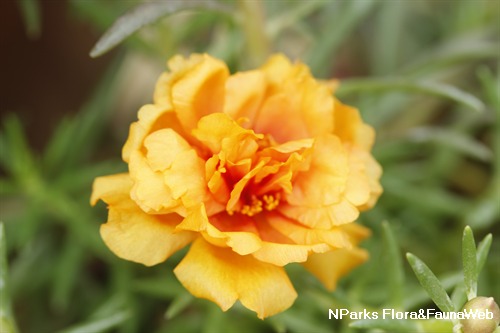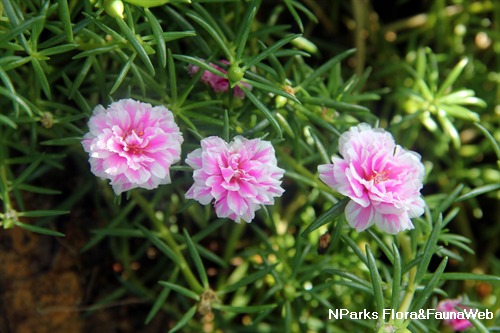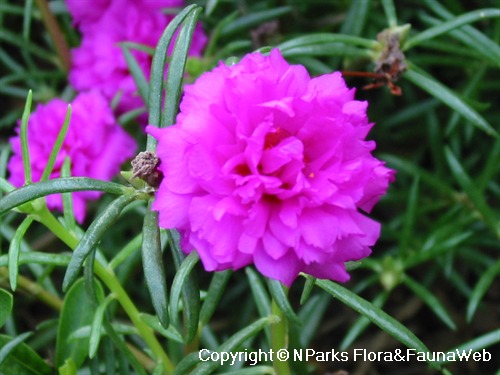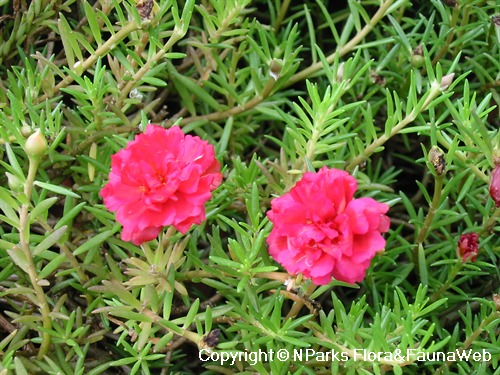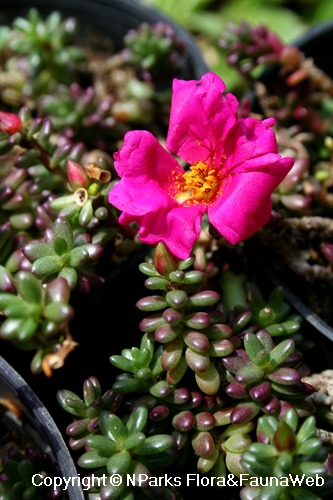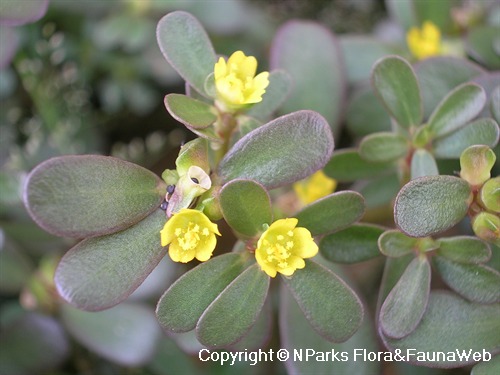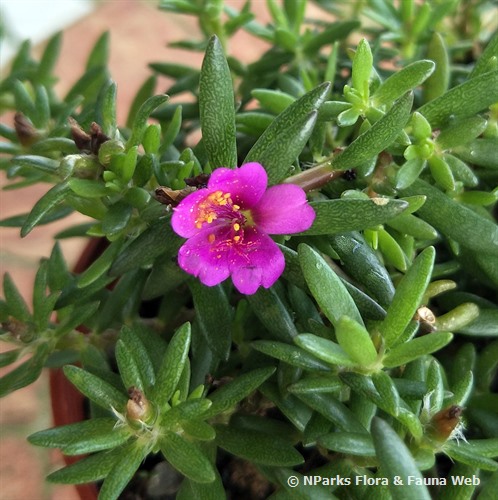
Back
Portulaca grandiflora (polypetalous)
| Family Name: | Portulacaceae |
| Common Name: | Japanese Rose, Moss Rose, Portulaca, 大花马齿笕, 午时花 |
Name
Classifications and Characteristics
| Plant Division | Angiosperms (Flowering Seed Plants) (Dicotyledon) |
|---|---|
| Plant Growth Form | Herbaceous Plant, Creeper |
| Mode of Nutrition | Autotrophic |
| Maximum Height | 0.2 m |
Biogeography
| Native Distribution | Southern Brazil, Uruguay and northern Argentina |
|---|---|
| Local Conservation Status | Non-native (Horticultural / Cultivated Only) |
Description and Ethnobotany
| Foliage | Foliage is succulent, both stems and leaves are thick and somewhat soft. Leaves are sessile, alternate, cylindrical and about 2cm long, with a pointed apex. |
|---|---|
| Flowers | The polypetalous cultivars bear flowers that are about 3.5cm across, in many colours in the warm spectrum (white, yellow, orange, pink and red), and also exhibit some variegation. They are rose-like, and hence are commonly known as "Japanese Rose". Flowers only open in bright sunlight, and do not open under overcast skies or at night. They are borne on the terminal ends of the stems. Flowers last about 3 days on the plant, but are quickly succeeded by new flowers. |
| Others - Plant Morphology | This is a low-growing annual plant that is popular as an ornamental groundcover. Propagation: Propagated from seeds, which germinate rapidly (often within less than 5 days), preferably in trays of a light, well-drained seedling mix or directly in place. They grow rapidly and can start flowering in less than 8 weeks. |
| Cultivation | These plants are drought tolerant and are conversely very susceptible to damage from over-watering. Make sure to plant them in very well-drained soil, and be careful when watering container-grown plants to make sure they are not over-watered. They require bright direct sunlight in order to thrive and flower. Possible pest problems are aphids, which can be controlled by washing off with water or spraying with mild soapy water. |
Landscaping Features
| Desirable Plant Features | Ornamental Flowers |
|---|---|
| Landscape Uses | Container Planting, General, Coastal, Suitable for Rooftops, Flowerbed / Border, Suitable for Hanging Baskets, Groundcover |
| Thematic Landscaping | Rockery / Desert Garden, Naturalistic Garden, Wildflower Garden |
Fauna, Pollination and Dispersal
| Seed or Spore Dispersal | Abiotic (Explosive Dehiscence) |
|---|
Plant Care and Propagation
| Light Preference | Full Sun |
|---|---|
| Water Preference | Little Water |
| Plant Growth Rate | Fast |
| Rootzone Tolerance | Fertile Loamy Soils, Well-Drained Soils, Poor Infertile Soils, Saline Soils / Salt Spray, Easy to Grow, Drought Tolerant, Shallow Media |
| Maintenance Requirements | Moderate |
| Propagation Method | Seed, Stem Cutting |
Foliar
| Foliage Retention | Evergreen |
|---|---|
| Mature Foliage Colour(s) | Green |
| Mature Foliage Texture(s) | Smooth, Thick |
| Foliar Type | Simple / Unifoliate |
| Foliar Arrangement Along Stem | Spiral |
| Leaf Area Index (LAI) for Green Plot Ratio | 4.5 (Shrub & Groundcover - Dicot) |
Non - Foliar and Storage
| Stem Type & Modification | Herbaceous, Runner / Stolon |
|---|---|
| Root Type | Underground (Fibrous Root), Aboveground (Buttress Root) |
| Specialised Storage Organ(s) | Aboveground |
Floral (Angiosperm)
| Flower & Plant Sexuality | Bisexual Flowers |
| Flower Colour(s) | Orange, Pink, Red |
|---|---|
| Flowering Period | Free-Flowering |
| Flowering Habit | Polycarpic |
Fruit, Seed and Spore
| Fruit Classification | Simple Fruit |
|---|---|
| Fruit Type | Dehiscent Dry Fruit |
Image Repository
Others
| Master ID | 1065 |
|---|---|
| Species ID | 2358 |
| Flora Disclaimer | The information in this website has been compiled from reliable sources, such as reference works on medicinal plants. It is not a substitute for medical advice or treatment and NParks does not purport to provide any medical advice. Readers should always consult his/her physician before using or consuming a plant for medicinal purposes. |

